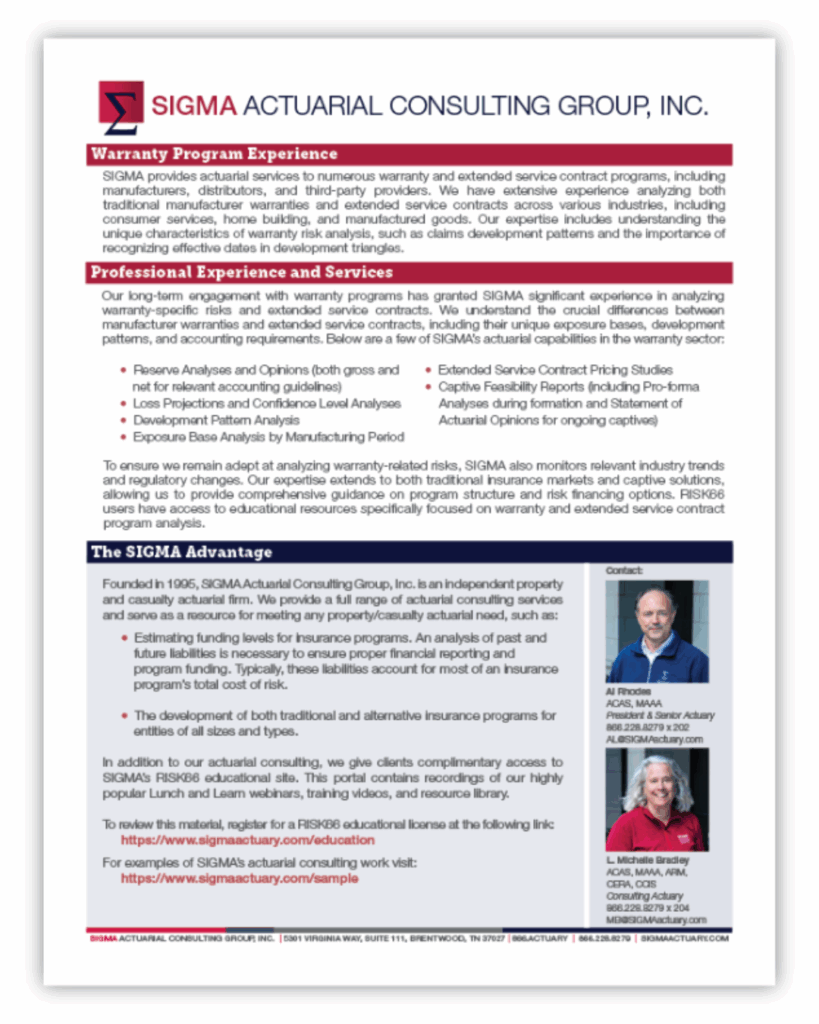As legislative and regulatory requirements surrounding insurance coverage become increasingly complex and dynamic, organizations must rely on advanced actuarial analysis to ensure sound risk management and compliance. The constant evolution of legal frameworks demands a clear understanding of critical factors such as implementation timelines, effective dates, and whether changes apply retroactively or prospectively.
SIGMA has extensive experience in supporting companies whose insurance programs are affected by regulatory risks. Generally, these types of events involve a change in legislation enacted by a regulatory body which can impact a company's operations or risk exposure. Our actuarial services help clients quantify the effect of new laws and regulations on their risk portfolios, pricing structures, and coverage strategies.
Our latest blog and one-page summary focuses on this important topic, outlining the range of services SIGMA provides and highlighting our experience in managing the implications of various types of legislative and regulatory changes. Whether addressing industry-specific reforms or broader statutory developments, SIGMA delivers insight and clarity to navigate uncertainty. Our latest one-pager is just one of the many documents found in our complimentary RISK66 education portal. Already a user? Login.
In addition to outlining the types of services SIGMA offers and highlighting our experience with legislative and regulatory changes, the summary below includes key information regarding recent legislative and regulatory changes.
California AB35 (Effective on Jan 1, 2023):
AB35 introduces significant reforms to California’s medical malpractice framework, including revised attorney fee structures and increased limits on noneconomic damages. The legislation establishes a phased increase in damage caps and adjusts thresholds for structured settlement payments, resulting in greater potential exposure for healthcare providers and insurers.
- AB35 updates California’s Medical Injury Compensation Reform Act of 1975 (MICRA) which addresses medical malpractice, attorney fees, and damages for noneconomic losses.
- AB35 replaces MICRA’s flat contingency fee limit system with a tiered one: The contingency fee would be up to 25% of the recovery amount if the claim is settled before filing a lawsuit or arbitration, up to 33% of the recovery amount if the claim is settled after a complaint or arbitration demand is filled, and a higher percentage is possible if the case goes to trial or arbitration subject to court approval for “good cause".
- AB35 also implements new noneconomic damage caps:
- Injury that does not involve wrongful death
- $350,000 for healthcare providers and institutions
- An additional $350,000 for unrelated providers and institutions
- Increases by $40,000 per year, with a maximum cap of $750,000
- Any action for wrongful death
- $500,000 for healthcare providers and institutions
- An additional $500,000 for unrelated providers and institutions
- Increases by $50,000 per year, with a maximum cap of $1 million
- Annual increases begin Jan 1, 2023, for a 10-year period, with the maximum cap amounts of $750,000 and $1,000,000 adjusted each year by 2% for inflation on Jan 1, beginning Jan 1, 2034.
- Injury that does not involve wrongful death
- Finally, AB35 raises the threshold for mandatory periodic payments (instead of lump-sum payments) to $250,000 from $50,000.
Adult Survivors Act NY (Effective on May 2022):
The Adult Survivors Act (ASA) temporarily revived time-barred civil claims for certain sexual offenses, providing a one-year window for individuals to pursue legal action. This legislation aligns with broader national trends, as several other states have enacted similar laws extending or reopening the statute of limitations for survivors of sexual abuse.
- Enacted in May 2022, the ASA allowed alleged victims of sexual offenses, whose claims were previously time-barred by the statute of limitations, to file civil lawsuits during a one-year lookback window beginning November 24, 2022.
- States that have implemented similar laws:
- California established The Sexual Abuse and Cover-Up Accountability Act that established a three-year lookback period for incidents that happened after Jan 1, 2009. The period expired on Dec 31, 2024.
- Louisiana Supreme Court passed a law that reopened the window for adult survivors of childhood sexual abuse to file lawsuits in 2021. The court reinstated this lookback period in 2022, allowing claims to be filed until June 2027.
- Arkansas enacted a revival statute that brings back old cases with a lookback window extending from August 1, 2023, to February 1, 2026. However, this window only applies to minors and adults considered "vulnerable" due to mental health conditions or similar disabilities.
Georgia Senate Bills 68 and 69 (Signed April 21, 2025):
Senate Bills 68 and 69 represent a comprehensive tort reform initiative in Georgia aimed at improving fairness in civil litigation and reducing liability costs by amending Titles 9, 13, 40 and 51 of the Official Code of Georgia. The annotated legislation introduces procedural and evidentiary changes intended to enhance transparency, limit excessive damage claims, and clarify standards of liability in certain negligence cases.
Senate Bill 68:
- Most provisions take effect immediately and apply retroactively to pending cases, though certain parts (negligent security, special medical damages, and seatbelt evidence) apply only to causes of action arising on or after the date signed into law.
- SB 68 requires the disclosure of third-party litigation funding and permits courts to take into judicial consideration whether a plaintiff was wearing a seatbelt, potentially reducing automobile liability losses.
- Rules for voluntary dismissal were amended to limit the plaintiff’s ability to dismiss a case without the permission of both the defendant and the court
- Jurors may now see both the billed and paid amounts for medical care, limiting inflated medical damage claims and improving claim valuation accuracy
- Allows the courts to separate fault and damages phases of a trial, helping reduce bias and improving fairness.
- The framework for liability claims based on negligence is clarified, narrowing the circumstances in which an owner or occupier can be held liable for third-party criminal acts on their premises.
Senate Bill 69:
- Complements SB 68 as part of the tort reform package.
- Requires disclosure of third-party litigation funding and regulates litigation financing arrangements.
- Establishes discovery and registration requirements for funding agreements for $25,000 or more.
- Provisions governing litigation funding take effect in 2026.
Florida HB837 (Signed March 24, 2023):
HB 837 enacts substantial civil litigation reforms in Florida, including changes to comparative negligence standards, statutes of limitations, and the allocation of legal expenses. The legislation is designed to limit excessive litigation, streamline the legal process, and reduce liability exposure for defendants.
- Signed into law on March 24, 2023, which transitions Florida from a pure comparative negligence system to a modified comparative negligence system, under which a plaintiff who is found to be more than 50% at fault is barred from recovering damages.
- Reduces the statute of limitations for negligence claims from 4 years to 2 years.
- Places the financial responsibility for legal representation on the insureds rather than the insurers.
Texas SB 30 and 39 (Filed March 13, 2025), HB4688 (Filed March 12, 2025):
These proposed bills reflect ongoing efforts in Texas to reform civil liability laws with the goal of reducing insurance costs and limiting excessive litigation. The legislation focuses on capping certain damage awards and revising liability standards in commercial motor vehicle cases, particularly regarding employer responsibility.
- Not yet signed into law as of August 28, 2025, these bills were filed during the 2025 legislative session with the objective of reducing insurance costs in Texas.
- SB30 aims to curb nuclear medical verdicts (awards exceeding $10 million) by limiting the amounts plaintiffs may submit in personal injury or wrongful death cases.
- SB39 and HB4688 propose amendments to Texas civil liability statutes related to commercial motor vehicle accidents, specifically changing the standards by which employer defendants may be held liable for the negligent actions of their employees.
Tennessee HB0004/SB0418 (Filed but Not Signed):
Recent amendments to the Tennessee Governmental Tort Liability Act increase the statutory caps on recoverable damages for bodily injury, death, and property damage in claims brought against local governmental entities. These changes reflect an effort to modernize liability limits in response to evolving legal and economic considerations.
- Increases the recovery limit for bodily injury or death of one person from $300,000 to $750,000.
- Increases the recovery limit for bodily injury or death of all persons in a single incident from $700,000 to $1.5 million.
- Increases the recovery limit for injury to or destruction of property from $100,000 to $250,000.
- The update would be effective July 1, 2025, if signed into law.
Colorado HB24-1472 (Effective on Jan 1, 2025):
Enacted in 2024, this legislation raises the caps on noneconomic damages in personal injury and wrongful death cases. The changes are designed to adjust damage limits across various tort and medical malpractice claims to better reflect current economic conditions.
- Raises the cap for noneconomic damages in general tort actions to $1.5 million, with inflation adjustments beginning in 2028; increases the cap for wrongful death damages to $2.125 million; sets the cap for noneconomic damages in medical malpractice wrongful death at $1.575 million by 2029; and raises the cap for noneconomic damages in medical malpractice injury claims to $875,000 by 2029.
Climate Change Related Legislation:
The SEC adopted climate-related disclosure rules in March 2024 but suspended them in March 2025.
- SEC Climate-Related Disclosure Rules
- On March 6, 2024, the SEC adopted climate-related disclosure rules requiring both domestic and foreign registrants to include extensive climate-related information in their registration statements and periodic reports. The rules also mandated that publicly traded insurers disclose climate-related risks that could impact their business and operations.
- On March 27, 2025, the SEC announced a freeze on the implementation of these climate disclosure rules.
GDPR and CCPA Cybersecurity Regulations:
The General Data Protection Regulation (GDPR) and the California Consumer Privacy Act (CCPA) are key data security laws designed to protect individuals’ personal information. While GDPR applies broadly to any organization processing the personal data of EU residents regardless of location, CCPA specifically governs businesses operating in California that meet defined thresholds.
- Although both the GDPR and the CCPA are designed to protect individuals’ personal data, they vary in scope and application.
- The GDPR applies to any organization, regardless of its location, which processes the personal data of individuals residing in the European Union.
- The CCPA applies to businesses operating in California that meet certain criteria, such as annual revenue or the volume of personal data processed.
As always, SIGMA is available to discuss solutions to challenges unique to a particular company or industry. Schedule a call today with one of our consulting actuaries.
We welcome your feedback by contacting us at support@SIGMAactuary.com.
© SIGMA Actuarial Consulting Group, Inc.

